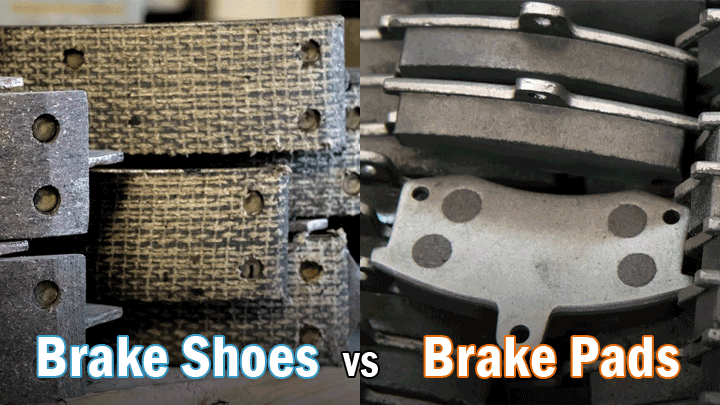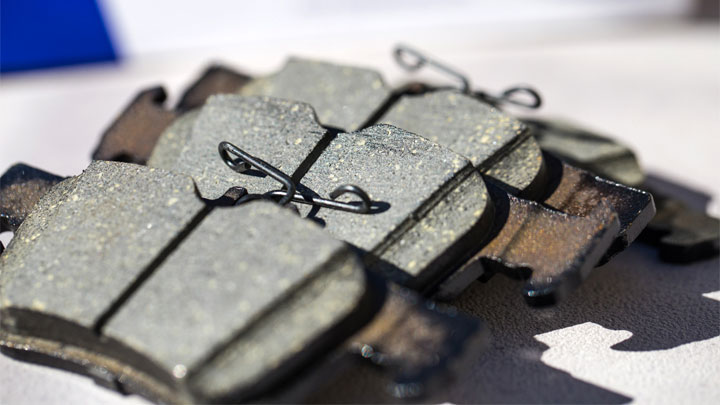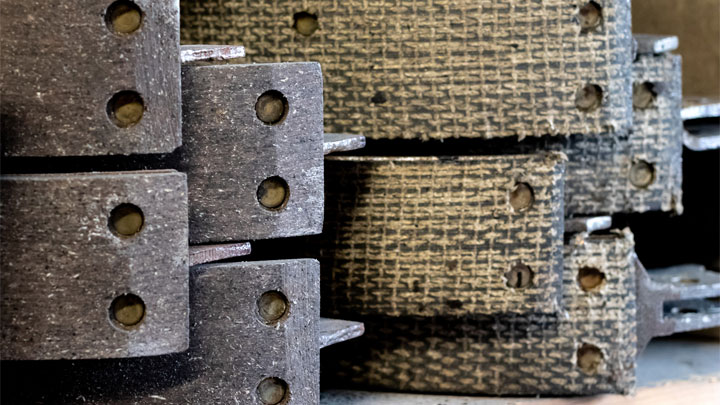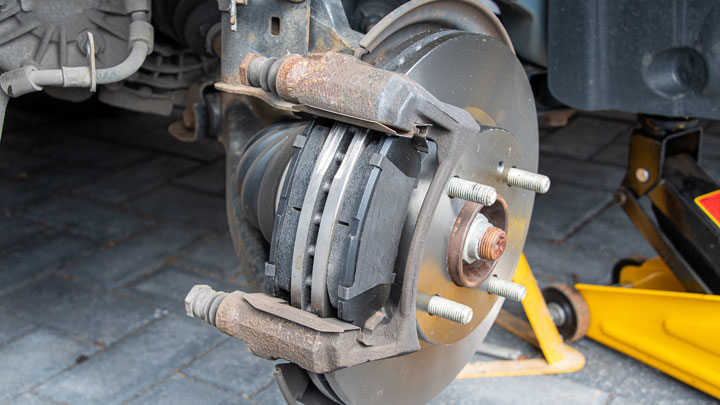Brake Shoes vs Brake Pads (and Replacement Cost)
Stopping power depends on your brakes. While brake pads rule today, drum brakes with shoes prevailed in classics. Understanding these key systems is necessary knowledge for used car buyers and vintage gearheads alike.
Let’s go over the key differences between pads and shoes, including replacement costs and materials used, whether you’re restoring an old ride or considering a new one.

See Also: SOHC vs DOHC Engines
Brake Pads versus Brake Shoes
Disc brakes are the most common system for braking. It consists of a disc (rotor), caliper, and two brake pads at each wheel to create friction that will slow your car down. This friction is created by the two pads being pressed up against each side of the spinning rotor.
This system works well because it doesn’t generate a ton of heat. These days, disc brakes with brake pads are used on all four wheels but some vehicles may have brake pads on the wheels of the front axle and brake shoes on the wheels of the rear axle.
Brake shoes are an older system but are still used on the rear axle wheels of some vehicles. Instead of pads squeezing the brake rotor on disc brakes, the brake shoe pushes outward against a brake drum and causes friction that way.
This system generates a lot more heat than a disc brake setup, but the cost of replacing these pieces is much lower. The lower cost is because of the fact that brake shoes are older and easier to manufacture.
See Also: How Drum Brakes Work
Brake Pad Materials

Brake pads can be made of several different materials. Each material offers its own benefits and pitfalls.
The cheapest and most common material is semi-metallic. It is called semi-metallic because while there are metal shavings in the pad, it is held together with resin. This material is heavy, impacting the gas mileage of the car. This material will also cause the most wear and tear on the rotors of the car.
The most quickly worn out brake pads are ones made from organic materials. This might appeal to people that want to be a little more environmentally friendly, but these pads will wear down extremely quickly and will also release dust when braking. These pads are also the quietest which might appeal to some people.
The most expensive material on the market is ceramic. These brake pads are lightweight and durable, but the cost is more than any of the others, which can make these the least appealing option for some people.
Really, which material you opt for will be because of what you can afford and maybe even at the suggestion of a professional. But know that you have even more options when it comes to your brake pads.
Related: How Long Do Brake Pads Last?
Brake Shoe Materials

Because brake shoes are an older technology, they have used a number of different linings to press against the drum. Before the adverse effects of asbestos were discovered, asbestos was the most commonly used material in the brake shoe.
Nowadays, brake shoes use a lining made of synthetic aramid. Aramid fiber is used in several different things but is a common replacement for anything that used asbestos before. This isn’t the only material used, but because of its heat-resistance, the synthetic fibers are often one of the favorites.
Which material you decide to use will probably be from what is available or suggested by the mechanic that is working on your car.
Brake Pad Replacement Cost
Best places to order parts? See: 19 Best Online Auto Parts Stores

While typical quotes for brake replacement include the labor, it is important to know how much the parts are costing you. For brake pads with a range of different materials, you wind up with a range of cost that you can wind up paying.
The lower end materials (ie: semi-metallic) could cost as little as $50 per axle, but the higher end ceramics could cost as much as $150 per axle with organics somewhere in the middle. These costs will fluctuate with the places that you go.
There could also be an increase in cost when you’re going to a mechanic because they’re ordering the parts for you. But when you add on the cost of labor for brake pads alone, then replacing an axel’s worth of brake pads can cost $100 to $200.
But that cost will depend on the kind of brake pad you want. A set of good brake pads may cost you $30 per axle but going with the best brake pads can cost 2-3 times that. If you have the skill and ability to change the brake pads yourself, you can cut your costs way down.
See Also: Symptoms of Worn Brake Pads
Brake Shoe Replacement Cost

With the fact that brake shoes are older systems and easier to manufacture, you can expect to pay a little less for replacing these parts than you would for the brake pads. However, just as with the brake pads, there is a range of costs since there is more than one material that you can use for your car.
Some places may charge only $100 for both the materials and the labor required to deal with brake shoes, but you could easily wind up paying up $300 if you want better materials and are having a mechanic doing the replacement for you.
As with replacing brake pads, if you can do the physical labor yourself, then you can cut costs way down by just paying for the parts. However, the time that you dedicate to this work is also a cost to consider.
So Which is Better?
Whether restoring a classic or buying used, understanding brake systems protects your investment. While less expensive, drum brakes and shoes can’t match the superior stopping power of disc brakes and pads. But for infrequent drivers or vintage builds, shoes still get the job done.
When evaluating vehicles, consider braking components as carefully as you would engines.
- Replace the Engine or Replace the Car? (11 Factors to Consider) - Apr 11, 2024
- Plastic Piece Dragging Under Your Car? (What It Is and What To Do) - Mar 21, 2024
- Timing Belt vs Timing Chain (What’s the Difference?) - Feb 27, 2024

Great informative article. Thans. IMHO, brake pads – and rotors and calipers – are SO much faster and easier to replace DIY than brake shoes (stuck drums and SPRINGS!) that it’s worth the cost to get disc brakes all around.